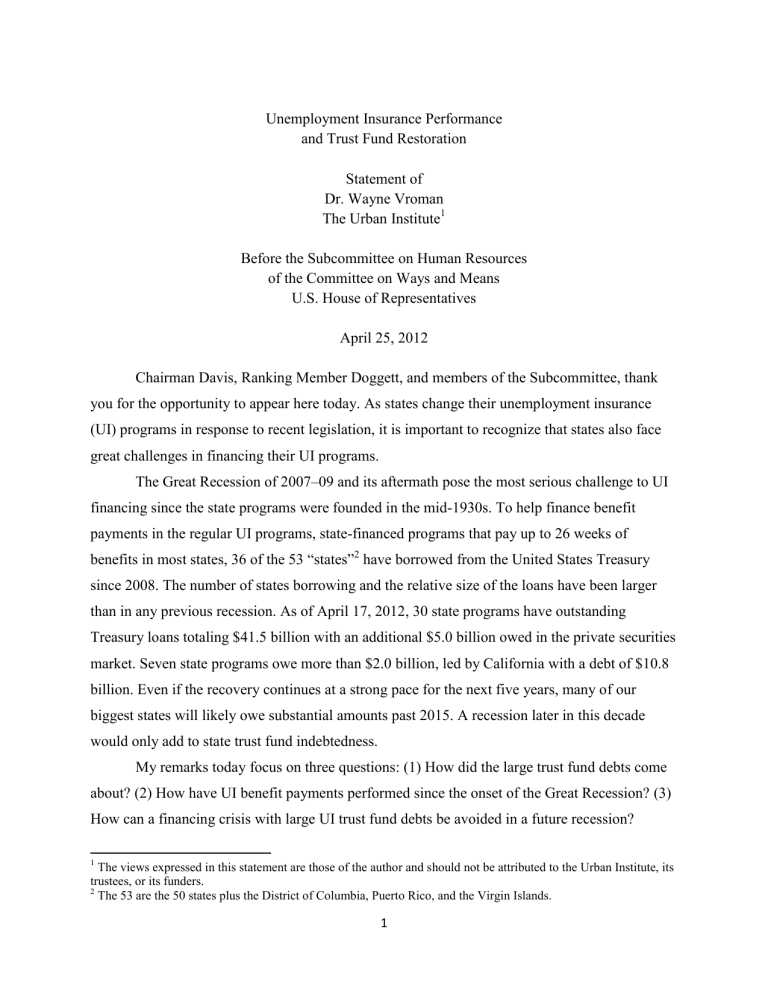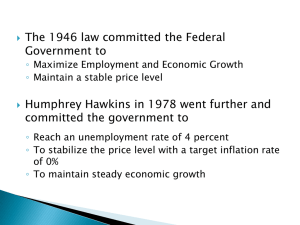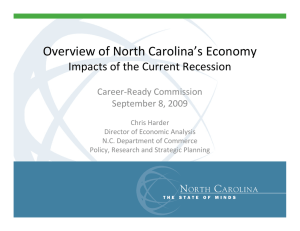Unemployment Insurance Performance and Trust Fund Restoration Statement of

Unemployment Insurance Performance and Trust Fund Restoration
Statement of
Dr. Wayne Vroman
The Urban Institute
1
Before the Subcommittee on Human Resources of the Committee on Ways and Means
U.S. House of Representatives
April 25, 2012
Chairman Davis, Ranking Member Doggett, and members of the Subcommittee, thank you for the opportunity to appear here today. As states change their unemployment insurance
(UI) programs in response to recent legislation, it is important to recognize that states also face great challenges in financing their UI programs.
The Great Recession of 2007–09 and its aftermath pose the most serious challenge to UI financing since the state programs were founded in the mid-1930s. To help finance benefit payments in the regular UI programs, state-financed programs that pay up to 26 weeks of benefits in most states, 36 of the 53 “states”
2
have borrowed from the United States Treasury since 2008. The number of states borrowing and the relative size of the loans have been larger than in any previous recession. As of April 17, 2012, 30 state programs have outstanding
Treasury loans totaling $41.5 billion with an additional $5.0 billion owed in the private securities market. Seven state programs owe more than $2.0 billion, led by California with a debt of $10.8 billion. Even if the recovery continues at a strong pace for the next five years, many of our biggest states will likely owe substantial amounts past 2015. A recession later in this decade would only add to state trust fund indebtedness.
My remarks today focus on three questions: (1) How did the large trust fund debts come about? (2) How have UI benefit payments performed since the onset of the Great Recession? (3)
How can a financing crisis with large UI trust fund debts be avoided in a future recession?
1
The views expressed in this statement are those of the author and should not be attributed to the Urban Institute, its trustees, or its funders.
2
The 53 are the 50 states plus the District of Columbia, Puerto Rico, and the Virgin Islands.
1
The Origins of the Current Situation
The scale of state UI trust fund indebtedness reflects the combined effects of four identifiable factors. These are low pre-recession reserve balances, the unusual depth and duration of the recession, the timing of the downturn, and the continuing loss of employment and associated UI tax revenues from the recession and the slow recovery. The first two factors are responsible for the largest part of current indebtedness, but the final two have also contributed to the loss of trust fund reserves. Each will be discussed briefly.
Low Pre-Recession Reserves
Chart 1 displays aggregate year-end UI reserve ratios (net reserves as a percentage of total covered payroll) from 1960 to 2011. The reserve ratio consistently exceeded 2.0 percent of payroll before 1973, while it has never reached 2.0 percent since then. Three early periods of economic recovery were accompanied by large-scale trust fund build-ups (1961–69, 1976–79, and 1983–89). Between 1983 and 1989, the reserve ratio increased from -0.47 percent to 1.92 percent. Later recovery periods had much smaller reserve ratio increases. This meant that the pre-recession reserve ratio was lower in 2001 than it had been in 1989 and even lower at the end of 2007 than in 2001. The reserve ratio was 0.79 percent of payroll in December 2007, the lowest ever for a pre-recession year.
3
Chart 1. UI Program Reserve Ratio, 1960–2011
4.0
3.0
2.0
1.0
0.0
-1.0
1960 1965 1970 1975 1980 1985 1990 1995 2000 2005 2008 2011
Reserve Ratio - Net Reserves as Percent of Payroll - Dec. 31
Source: Data on net reserves and total payroll used in the calculations are from the Office of Unemployment
Insurance of the U.S. Department of Labor.
3
The second-lowest pre-recession reserve ratio was 0.91 percent just before the 1980 recession.
2
Note in chart 1 that the past three years are the only period when net reserves were negative for three consecutive years. Based on recent developments, it appears net reserves are likely to remain negative for three or four more years. The final section of this testimony discusses measures to foster reserve accumulations in the states.
How low were UI trust fund reserves at the end of 2007? A common measure of UI reserve adequacy is the reserve ratio multiple, or RRM (also called the high cost multiple or
HCM). The RRM is measured as a ratio of two ratios. The numerator is the reserve ratio, reserves as percentage of payroll—that is, the series depicted in Chart 1. The denominator is the highest previous annual benefit payout rate, also expressed as a percentage of payroll. It was 2.22 percent during January-December 1975. Thus, the RRM at the end of 2007 was 0.36. Many have suggested that a pre-recession RRM of 1.0 (representing 12 months of benefits) is generally an adequate level. Aggregate net reserves totaled $38.2 billion at the end of 2007, but the associated
RRM of only 0.36 meant that the reserves represented only 4.3 months of benefits when paid at the highest-ever payout rate.
The explanation for low reserves before the Great Recession lies mainly in the failure of
UI tax revenue to restore trust fund balances following the recessions of 1991 and 2001 and not the effects of unusually high benefit payout rates during the 1990s and 2000s.
4
While benefit payout rates between 1990 and 2008 were low relative to earlier periods, UI tax revenues were even lower, leading to the long-run decrease in trust fund reserve adequacy. The state UI programs entered the Great Recession with historically low trust fund reserves.
The Deep Recession
The recession that commenced in November 2007 was the deepest and longest of the entire post–World War II period. Between 2007 and 2009, the national unemployment rate doubled from 4.6 percent to 9.3 percent. It then increased to 9.6 percent in 2010 and has remained high, averaging 8.9 percent during 2011 and 8.3 percent during the first three months of this year. Unemployment averaged 14.8 million in 2010 and 13.7 million in 2011; it has remained above 12.5 million during January–March 2012. Associated with increased unemployment has been an increase in average (mean) unemployment duration, which reached
4
One summary of the patterns of UI benefits and taxes for five-year periods extending back to the 1950s is given in
Wayne Vroman, “Unemployment Insurance: Current Problems and Future Prospects,” Unemployment Insurance
Brief No. 2 (Washington, DC: National Academy of Social Insurance, 2011).
3
the unprecedented levels of 24.4 weeks in 2009, 33.0 weeks in 2010, and 39.3 weeks in 2011.
Before the Great Recession, mean duration had reached 20.0 weeks just once, in 1983.
The Great Recession, with its high unemployment and long unemployment duration, caused a large increase in UI benefit payments. Table 1 summarizes annual unemployment and
UI benefits from 2007 to 2011. The payments data distinguish regular UI benefits from
Emergency Unemployment Compensation (EUC), Federal-State Extended Benefits (EB), and
Federal Additional Compensation (FAC). FAC made payments of $25 a week to all UI recipients during most of 2009 and 2010 but was phased out in late 2010.
Several features of Table 1 are noteworthy. UI was designed to be a countercyclical program, and the table vividly illustrates its cyclical responsiveness. During 2009 and 2010, total
UI benefits (including payments to the long-term unemployed) were four times total benefits of
2007. Total benefits during 2011 were three times the 2007 total. All four payments identified in the table contributed to these increases. During 2010 and 2011, payments from the two extended benefit programs (EUC and EB) exceeded regular UI benefits for the only time in the history of extended benefit programs. Note also that EB and FAC paid large amounts during 2009 and
2010. These benefit payments helped stabilize the incomes of millions of American families and are continuing to do so this year.
Table 1.
Unemployment and Annual UI Benefits, 2007–11
Unemployment
Regular UI
Benefits
EUC
Benefits
Federal-
State EB FAC
2007
2008
2009
2010
7.1
8.9
14.3
14.8
32.4
43.1
78.8
58.6
7.9
42.3
66.0
0.0
0.0
6.0
9.2
-
-
9.5
10.3
32.4
51.0
136.6
144.0
2011 13.7 47.2 47.2 10.0 - 104.4
Source: Annual data from the U.S. Department of Labor. Unemployment from the Bureau of Labor Statistics and unemployment benefits from the Office of Unemployment Insurance.
Notes: Unemployment in millions of people. Benefit payments in billions of dollars.
Total UI
Benefits
The financing of regular UI benefits is the responsibility of the state programs. The $78.8 billion paid in 2009 represented 1.69 percent of payroll. While the 2009 payout rate was high
(the highest since 1982), annual payout rates above 1.69 percent occurred during five earlier recessions (1949, 1958, 1961, 1975, and 1982). The high payouts of 2008–11 have caused 36 of
53 state UI programs to borrow sometime during the past four years. Borrowing from the United
4
States Treasury is well established; seven or more states have borrowed in every recession since the mid-1970s, with much higher numbers during 1975–77 and 1980–83.
The third and fourth factors (the timing of the downturn and continuing low employment during the economic recovery) have both negatively affected UI tax revenue. While each is less important than the low pre-recession trust funds and the severity of the recession, both have had measurable effects on state UI trust fund balances and the volume of borrowing.
The Timing of the Downturn
Most states set UI taxes for the upcoming calendar year based on trust fund reserves as of
June 30. Net reserves on June 30 are usually similar to reserves at the end of the year, but not in
2008. Because UI payouts increased sharply during the second half of 2008 (roughly $10 billion more than in the second half of 2007), the end-of-year balance in 2008 was $10.7 billion lower than it had been six months earlier ($29.0 versus $39.7 billion). Thus, employers in most states were taxed at lower rates during 2009 because very little of the late-2008 surge in benefits entered the calculations that determined their 2009 tax rates.
Low Post-Recession Employment
The fourth factor, continuing low employment, has affected UI tax revenue every year since 2008. Covered employment in the decade before the recession grew 1.1 percent a year. If taxable covered employment had grown by 1.0 percent a year after 2007, it would have reached
110.8 million in 2010. Actual employment was 99.5 million in 2010, a shortfall of 10 percent.
The employment shortfall has been present every year since 2008, and it will persist for several future years. The depressing effect on UI tax revenue during 2009, 2010, and 2011 has averaged more than $3.0 billion a year.
The combined effects of these four factors caused a large-scale drawdown of reserves in nearly all states and prompted borrowing from the U.S. Treasury by most UI programs. The confluence of the four can be characterized as a perfect storm in their effects on UI trust funds.
UI Benefits in the Great Recession
The benefit payments from all tiers of UI programs as summarized in table 1 have performed an important stabilizing function for the overall economy. The benefits also helped dampen the increase in poverty stemming from higher unemployment.
5
During 2009 and 2010, I directed a model-based analysis of the stabilizing effects of the
UI program.
5
The analysis used the Moody’s Economy.com econometric model to assess UI’s effect on the time paths of real GDP and employment. The analysis used state-level detail on regular UI benefits, combined EUC and EB benefits, and state UI taxes to trace alternative time paths of real GDP and employment with emphasis on the period from July 2008 to June 2010.
Four findings from that analysis can be highlighted: the increased regular UI benefits closed about one-tenth (0.105) of the real GDP shortfall caused by the recession; extended benefits (EUC plus EB) closed about one-twelfth (0.085) of the real GDP shortfall; because there was very little response of regular UI taxes during 2009 and 2010, there was practically no offsetting tax-related effects; and the multiplier effect on real GDP for each dollar of added regular UI benefits was 2.0 (for extended benefits it was also 2.0). When all parts of the analysis are combined, the effect of UI in closing the GDP gap caused by the recession was 0.183 during the eight calendar quarters between July 2008 and June 2010.
Table 2 uses the multipliers from that earlier analysis and benefit data from Table 1 to estimate the stimulative effects of UI on real GDP during the Great Recession. Column 4 shows the increase in benefits above 2007 with benefits measured in real terms (dollars of 2005 purchasing power). Column 5 shows the effects on real GDP assuming a multiplier of 2.0 for both regular and extended UI benefits. During 2007, real GDP was $13,228 billion. From column 5, the stimulative effect of UI benefits during both 2009 and 2010 exceeded 1.4 percent of real GDP, and it exceeded 0.9 percent in 2011. Applying this methodology in 2012 entails more uncertainties, but it might suggest an increment to real GDP of 0.5 percent, with about half due to the continued payment of extended benefits. Alternative models and alternative analytic approaches would yield different point estimates to those in table 2, but the conclusion that UI benefits had a measurable effect in lessening the recession’s severity is widely held.
6
The increase in UI benefits during the Great Recession affected poverty, especially among households with long-term unemployment. Using 2009 family income data from the
Current Population Survey, the Congressional Budget Office (CBO) found that the national poverty rate of 14.3 percent in 2009 would have been 15.4 percent absent UI benefits. Among
5
Wayne Vroman, “The Role of Unemployment Insurance as an Automatic Stabilizer During a Recession,” ETAOP
2010-10 (Washington, DC: U.S. Department of Labor, Employment and Training Administration, 2010).
6
See Alan Blinder and Mark Zandi, “How the Great Recession was Brought to an End” (Princeton, NJ: Princeton
University, Department of Economics, 2010). The CBO’s analysis of the American Recovery and Reinvestment Act is at http://www.cbo.gov/ftpdocs/115xx/doc11525/05-25-ARRA.pdf
.
6
families with some unemployment, UI benefits reduced the poverty rate from 24.3 percent to
19.6 percent in 2009. Among families with unemployment and receiving UI benefits, the poverty rate of 11 percent that year would have been 21 percent absent UI benefits. Among the latter group, CBO found that UI benefits represented 5 percent of family income when unemployment duration was 1-–13 weeks but 22 percent of income when unemployment duration was 27 weeks or longer. The CBO analysis also found UI had large effects in reducing extreme poverty, defined to be income less than half the poverty threshold.
Table 2.
Estimated Effects of Increased UI Benefits on Real GDP, 2008–2011
2007
2008
2009
2010
2011
Total UI
Benefits
(1)
32.4
51.0
136.6
144.0
104.4
GDP Price
Deflator
2005 = 1.000
(2)
1.063
1.086
1.097
1.110
1.133
Real UI
Benefits
(1)/(2)
(3)
30.5
47.0
124.5
129.7
92.1
Increase in
Real Benefits over 2007
(4)
-
16.5
94.0
99.2
61.6
Effect on Real
GDP
(Mult. = 2.0)
(5)
-
33.0
188.0
198.4
123.2
Source: Data on UI benefits from Department of Labor, Employment and Training Administration, Office of
Workforce Security. GDP deflators from national income accounts.
Notes: Data in columns 1, 3, 4, and 5 in billions of dollars. Columns 3, 4, and 5 calculated by the author.
The loss of reserves in the regular UI program during 2009 and 2010 as shown in chart 1 was important in providing income support payments to millions of American families. The challenge now facing state UI programs is how to rebuild their reserves so a similar stabilizing performance can be repeated during the next recession.
Rebuilding State UI Trust Funds
Some important facts should be recognized in considering policies to improve future state
UI trust fund levels. Perhaps the most important single fact across the diverse state programs is the important positive role of tax base indexation in fostering solvency. Since the mid-1980s, 16 states and the Virgin Islands have operated with an indexed taxable wage base. Each year, the tax base in these states grows automatically with the growth in statewide wages. The indexation percentages (the ratio of the tax base to annual wages) range from 50 percent (North Carolina and Oklahoma) to 100 percent (Hawaii and Idaho).
7
While the UI tax bases in non-indexed states can be raised through state legislation, states have been strongly reluctant to enact increases except during financial crises. Even then, the increases have usually been small. Chart 2 vividly illustrates this situation using data from 1970 to 2012. During these 43 years, the federal UI tax base increased from $3,000 in 1970 to $7,000 in 1983 and has remained at $7,000 since 1983. Chart 2 then shows the simple average of the taxable wage base for the 16 indexed states and the 35 that are not indexed.
7
The average tax base for the 35 in 2012 is $10,682, less than $4,000 above the $7,000 federal tax base. In contrast, the simple average this year for the indexed states is $28,700.
Chart 2. State and Federal UI Tax Bases, 1970–2012
35,000
30,000
25,000
20,000
15,000
10,000
5,000
0
1970 1975 1980
Federal Tax Base
1985 1990 1995
Avg. - 16 Indexed
2000 2004 2008 2012
Avg. - 35 Not Indexed
Source: Based on state UI tax bases in the Office of Unemployment Insurance UI Financial Handbook.
The effect of indexation on UI financing is clear. The indexed states have much higher ratios of the tax base to average wages, higher taxable wage proportions, and higher reserve ratio multiples than non-indexed states. In December 2007, the simple averages of the RRMs for the two groups of states were 0.83 and 0.41, respectively. During the Great Recession, only 6 of the
16 indexed states needed Treasury loans, compared with 29 of 35 non-indexed states. Indexation has definitely improved state trust fund solvency in the long run.
7
Puerto Rico and the Virgin Islands are not included in the comparison.
8
During 2011, there were proposals to increase the base for the federal UI tax to $15,000 in 2014 and index the base after 2014 to the growth in average wages.
8
Three non-indexed states
(Connecticut, Rhode Island and Vermont) have a tax base of $15,000 or more. Because each state must have a tax base at least as high as the federal tax base, an increase to $15,000 would require most of the 35 non-indexed states to raise their bases. If an indexation proposal moves forward this year or next, Congress might consider a larger change to increase the taxable share of covered wages. The federal tax base of $7,000 in 1983 is equivalent to about $21,000 in 2014.
An increase to $21,000 (or higher) would have two effects: increase UI tax revenue in many states, and improve the equity of UI taxes by lessening the burden on low-wage employers.
A second fact to recognize is that, on average, the big states have the most serious funding problems. Table 3 helps illustrate this point. The 51 programs
9
have been ranked by their taxable covered employment in 2010. Four features of table 3 are noteworthy.
First, the large states entered the Great Recession with much lower reserves that other states (column 1). The 10 largest had particularly low reserves, but those ranked 11 to 20 also had low reserves. All 10 of the largest states have borrowed, as have 9 of the next 10 (column 2).
Washington is the only state among the top 20 that has not borrowed.
Second, the largest 10 states accounted for 70 percent of outstanding loans at the end of
2011, and the largest 20 for 90 percent (column 3). Their debts are substantial, exceeding 0.5 percent of payroll for all 10 of the largest states and for 4 of 10 in the 11–20 group (column 4).
Table 3.
Pre-Recession Reserves and Borrowing, 2008 to 2012
State Size Ranking
Average RRM
December 2007
(1)
States Borrowing
2008–12
(2)
Total Loans
December 2011
(3)
Loans 0.5 Pct. of Payroll
(4)
1–10
11–20
21–31
32–41
0.23
0.34
0.61
0.83
10
9
7
5
29.1
8.1
2.9
1.1
10
4
3
3
42–51
All 51 programs
0.68
0.36
4
35
0.4
41.5
Source: Calculations made at the Urban Institute using data from the Office of Unemployment Insurance.
2
22
Notes: RRMs are simple averages of state-level reserve ratio multiples. Loans are measured in billions of dollars.
8
The Unemployment Insurance Solvency Act of 2011 (S.386.IS). A recent analysis by the GAO also recommended indexing the UI tax base. See U.S. Government Accountability Office, “Unemployment Insurance Trust Funds”
Report GAO-10-440 (Washington, DC: GAO, 2010).
9
Puerto Rico and the Virgin Islands are not included.
9
Third, the funding situation across the states is highly varied. Some states, especially indexed states, entered the Great Recession with substantial reserves. While their trust funds were sharply reduced, they had sufficient reserves to pass through the recession and recovery without needing to borrow. Some states recognized their funding problems early and acted to raise revenue and make other adjustments to avoid borrowing or to limit the size and duration of their loans. The fact that several states have not borrowed or accumulated large debts must be recognized and addressed by any proposal to provide financial relief to states with large and long-standing debts. Proposals to provide partial debt relief were made in 2011 and may appear later this year or in 2013. If some form of debt relief is to be provided, it should be combined with rewards to the states that avoided large loans for lengthy periods. It must also be recognized that a federal initiative to provide partial debt relief in return for state actions to improve solvency will only slightly reduce the scale of the necessary financial adjustments (higher future
UI taxes) required to rebuild the depleted state trust funds.
Finally, borrowing in the private market is a palliative that does not change the total amount of state indebtedness. Idaho, Michigan, and Texas have already secured private loans.
Illinois has authorized private bonds, and other states may follow suit this year or next. Much of their motivation is to save on interest charges due on Treasury loans and to avoid automatic
Federal Unemployment Tax Act tax credit reductions. Reducing debts to the Treasury through borrowing in the private securities market does not change the fact of state UI program indebtedness, merely the mix of lenders to whom repayment is due. To a large extent, state borrowing in the private market appears to be a strategy to avoid near-term increases in UI taxes.
In an economy where the profits share of GDP is historically high
10
and UI taxes are less than 1 percent of employee compensation, it is more appropriate to raise UI taxes sooner to repay loans more quickly and start rebuilding reserves.
There is likely to be another recession later in the present decade. Repaying outstanding loans and building more adequate trust funds now should be a state priority so UI can more adequately perform as an automatic stabilizer of the macroeconomy during the next recession.
State UI programs need to be forward-funded to appropriately discharge their stabilization role.
10
The profits share of GDP in 2011 was 0.129, the highest share in all 65 years between 1947 and 2011.
10







